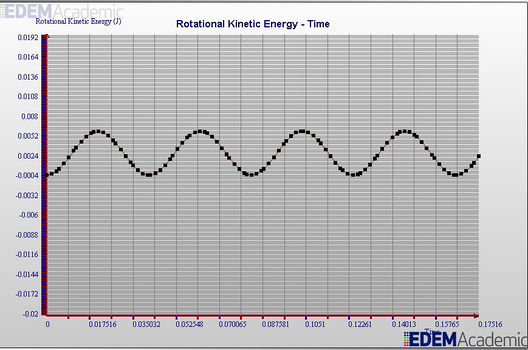Integrating Rotational Degree Of Freedom in EDEM — различия между версиями
Dainis (обсуждение | вклад) (→EDEM simulation) |
(→Additional Measures) |
||
| (не показано 18 промежуточных версий 2 участников) | |||
| Строка 8: | Строка 8: | ||
==Who we are== | ==Who we are== | ||
* [[Степанов Алексей]] (responsible for contact model) | * [[Степанов Алексей]] (responsible for contact model) | ||
| − | * [[Дзенушко Дайнис]] (responsible for factory and EDEM | + | * [[Дзенушко Дайнис]] (responsible for factory and EDEM simulation) |
| + | |||
==Factory== | ==Factory== | ||
We create 2 particles on a distance 0.1m and rotated at an angle of 5-15 () degrees;<br> | We create 2 particles on a distance 0.1m and rotated at an angle of 5-15 () degrees;<br> | ||
| Строка 23: | Строка 24: | ||
==Contact Model== | ==Contact Model== | ||
| − | + | In our project we used simple contact model.<br> | |
| + | All central forces we made zero. Also we made zero all torques except torque, which operates on a "small" particle. <br> | ||
| + | calculatedElem2AdditionalTorqueX = 1.0 * (elem1Orientation[7] * elem2Orientation[4] + elem2Orientation[5] * elem1Orientation[4] ); <br> | ||
| + | In this formula С = 1.0 | ||
| + | |||
==EDEM simulation== | ==EDEM simulation== | ||
===Globals:=== | ===Globals:=== | ||
| Строка 39: | Строка 44: | ||
<math>T = 2\pi\sqrt{\frac{C}{\theta}} = 0.106</math> | <math>T = 2\pi\sqrt{\frac{C}{\theta}} = 0.106</math> | ||
===Integration=== | ===Integration=== | ||
| − | We measured period using the Graph of angular velocity and got the result | + | We measured period using the Graph of angular velocity and got the result <br> |
<math>T = 0.082</math> | <math>T = 0.082</math> | ||
| − | ==== | + | ==Results== |
| + | So we got the result that is different to the analytic;<br> | ||
| + | Then we wrote small programm on C# that integrates the equalation in a simple way and got the result<br> | ||
| + | <math>T = 0.106</math><br> | ||
| + | We checked all in EDEM simulation; Changing parameters of particles, roll stiffness didn't gave any difference the results stayed different to analytic. | ||
| + | ==Additional Measures== | ||
| + | We chacked translational kinetic and potentional energy and they really equals to zero<br> | ||
| + | Graph of Rotational Kinetic energy | ||
| + | <gallery widths=580px heights=350px perrow = 1> | ||
| + | Файл:EDEM_Kin_Energy.jpg | ||
| + | </gallery> | ||
| + | As we can see the maximum of Kinetic energy is conserving. This graph was extended to 100 seconds(~1220 period)<br> | ||
| + | and conservation of Rotational Kinetic energy was prooved. Time step ~9.75e-07s. | ||
| + | |||
| + | |||
| + | [[Category: Студенческие проекты]] | ||
| + | [[Category: Механика дискретных сред]] | ||
| + | [[Category: Программирование]] | ||
Текущая версия на 02:04, 27 января 2013
Содержание
Task[править]
Understand - how rotational DOF are integrated inside EDEM. For this: prepare simulation which could be compared with analytics.
For this:
- Prepare factory that creates particles
- Prepare contact model which describes the rule of interaction
- Prepare EDEM simulation
- Measure something and compare it to analytic
Who we are[править]
- Степанов Алексей (responsible for contact model)
- Дзенушко Дайнис (responsible for factory and EDEM simulation)
Factory[править]
We create 2 particles on a distance 0.1m and rotated at an angle of 5-15 () degrees;
These particles are of 2 types "small" and a "big" one; Big particle has identity matrix as rotation matrix; Small particle is rotated using rotation matrix
Particles's velocity and angular velocity equals to zero;
Y and Z coordinates are the same (0.5,0.5); Only X is different (0.45 for "big" and 0.55 for "small");
- For small particle:
double OrientAngle = pi/12; // angle between particles in Radians
orientation[0] = 1.0; // Rotating particle. X axis.
orientation[4] = cos(OrientAngle);
orientation[5] = -sin(OrientAngle);
orientation[7] = sin(OrientAngle);
orientation[8] = cos(OrientAngle);
Contact Model[править]
In our project we used simple contact model.
All central forces we made zero. Also we made zero all torques except torque, which operates on a "small" particle.
calculatedElem2AdditionalTorqueX = 1.0 * (elem1Orientation[7] * elem2Orientation[4] + elem2Orientation[5] * elem1Orientation[4] );
In this formula С = 1.0
EDEM simulation[править]
Globals:[править]
Interaction: Particle to particle
Model: our contact model
No gravity
There are two materials "material" and "material_2" with different density for "material" 1000 for "material_2" 1.7e+05
Restitution: 0.5
No static and rolling friction
Particles:[править]
We create particles of 2 types;"big" with big moment of inertia (100kgm2 X-axis) and "small"(0.000285kgm2 X-axis);Both particles are made of 2 surfaces placed along Z-axis on a distance of 2 particle radius
Measures[править]
We measured the period of oscillation
Analytics[править]
Integration[править]
We measured period using the Graph of angular velocity and got the result
Results[править]
So we got the result that is different to the analytic;
Then we wrote small programm on C# that integrates the equalation in a simple way and got the result
We checked all in EDEM simulation; Changing parameters of particles, roll stiffness didn't gave any difference the results stayed different to analytic.
Additional Measures[править]
We chacked translational kinetic and potentional energy and they really equals to zero
Graph of Rotational Kinetic energy
As we can see the maximum of Kinetic energy is conserving. This graph was extended to 100 seconds(~1220 period)
and conservation of Rotational Kinetic energy was prooved. Time step ~9.75e-07s.
